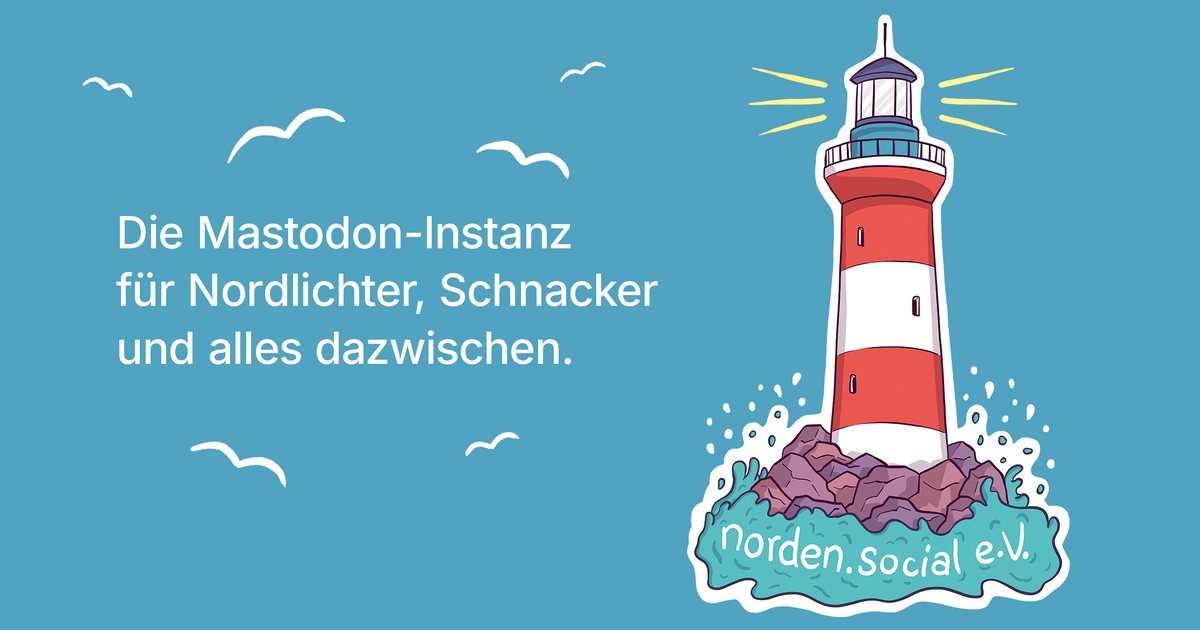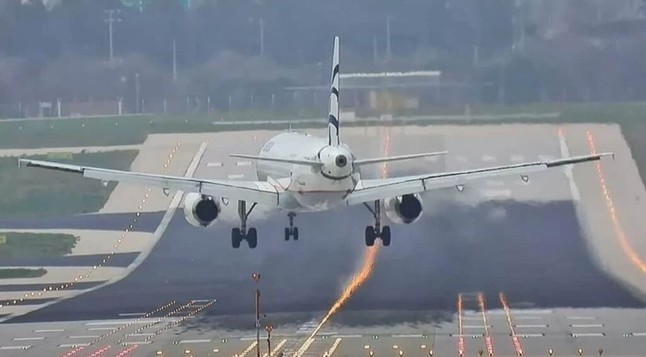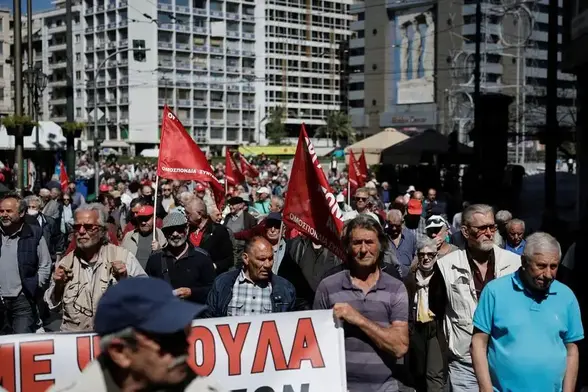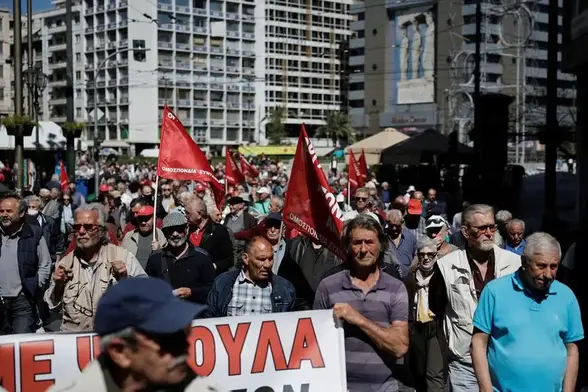Aviation Strikes Set To Disrupt Flights Tomorrow https://www.byteseu.com/904615/ #ADEDY #AirTrafficControl #AirTrafficControllers #AviationStrikes #CGIL #EasterHolidays #easyjet #FILT #FlightCancellations #Greece #HolidayTravel #Italy #Milan #Naples #StaffingShortages #strikes #TravelDelays #TravelDisruption #TravelWarning #UIL #UKSchoolBreak
Recent searches
Search options
#Airtrafficcontrollers
Greece Braces For Nationwide Strike On April 9 https://www.byteseu.com/899065/ #2025 #ADEDY #AirTrafficControllers #April9 #AthensLaborCenter #buses #CollectiveBargaining #CostOfLiving #Greece #GreeceNews #GreekNews #GSEE #HousingCrisis #journalists #MunicipalEmployees #NationwideStrike #POESY #PublicTransport #seafarers #teachers #TourismWorkers #trains #trolleybuses #WageIncreases
https://www.europesays.com/1974392/ Greece Braces For Nationwide Strike On April 9 #2025 #ADEDY #AirTrafficControllers #April9 #AthensLaborCenter #buses #CollectiveBargaining #CostOfLiving #greece #GreeceNews #GreekNews #GSEE #HousingCrisis #journalists #MunicipalEmployees #NationwideStrike #POESY #PublicTransport #Seafarers #teachers #TourismWorkers #Trains #trolleybuses #WageIncreases #Ελλάδα #νεα
The #TSA should #Strike. #AirTrafficControllers too. All non-healthcare federal employees as well. Everyone else should provide mutual aid until #DOGE is shut down and spending control returned to #Congress.
We've all forgotten who, actually, holds the power. Its the people with the power, and will, to say "No."
Federal employees are terrorized. They need a #GeneralStrike.
“PATCO on steroids”: Trump’s TSA union busting sparks calls for a general strike | Salon.com
https://www.salon.com/2025/03/11/patco-on-steroids-trumps-tsa-union-busting-sparks-calls-for-a-general-strike/
Notice that these sentences are nowhere to be found in Musk's post:
'Me and DOGE have totally f*cked up the FAA.'
'US skies are not safe right now.'
'If you come back, I promise you won't get fired on short (or no) reason without cause.'
"Air traffic controllers are required by law to retire at 56. It is a high-stress, high-intensity job that requires intense focus. The retirement rules are there to keep us all safe. This fucking guy has no clue what's he's doing.
I'll be heading up the Bellevue protest and we've got an amazing crew holding down all these locations. Come join us! #teslatakedown
-E Sutton
@nitpicking Yes, but my concern is the *asymmetry* in which #MAGA cult members have been trained to see the world. If the near miss had been due to #FAA failure (apparently it wasn’t), the #AirTrafficControllers would’ve been doxxed within an hour. But because the fault lies with a private company, it’s “Crisis averted, let’s get back to axing government #regulations and cutting #taxes for our dear ruling #Broligarchs.”
Anti-government protest action shuts down air traffic in Belgium https://www.byteseu.com/752892/ #AirTraffic #AirTrafficControllers #Belgium #BrusselsAirport #Government #NationwideProtest
#Airtrafficcontrollers + all federal employees were emailed by the #Trump administration urging them to #quit #resign their #jobs and take mass #buyouts just 24 hours after the D.C. plane crash. They were among hundreds of thousands of federal workers sent the email at 8.30 p.m. Thursday to push the extraordinary offer by Trump’s aides to get civil servants to quit en masse. https://www.thedailybeast.com/trump-admin-emails-air-traffic-controllers-quit-your-jobs/
People with intellectual #disabilities do lots of #jobs – but they don’t direct air traffic
No, the #FAA did not recruit people w/intellectual disabilities to work as #AirTrafficControllers.
Despite what #Trump said Thurs – "They can be air traffic controllers" – that's NOT how disability hiring works, says Chai Feldblum, a #disability lawyer & fmr commissioner of the #EEOC.
#labor #Trumpaganda #propaganda #gaslighting #discrimination #bigotry
https://www.npr.org/2025/01/30/nx-s1-5280368/intellectual-disabilities-air-traffic-controllers-faa-trump
Today in Labor History October 20, 1980: As a presidential candidate, Ronald Reagan wrote a letter to PATCO President Robert Poli promising that if the air traffic controllers union endorsed him, he would “take whatever steps necessary to provide them with the most modern equipment available and to adjust staff levels and work days so that they were commensurate with achieving a maximum degree of public safety.” The union naively endorsed Reagan and, within a few short months, President Reagan fired the air traffic controllers for engaging in an “illegal walkout” over staffing levels and working conditions. Their nationwide strike began on August 3, 1981, after workers rejected the government's final contract offer. Most of the 13,000 strikers ignored orders to go back to work and were fired on August 5. The mass firing of unionized workers, and the inability of the labor movement, as a whole, to respond to the crisis, led to the rapid downhill spiral of union power and membership. For example, in the years immediately after the PACTO strike, other major employers chose to fire striking workers en masse and replace them with scabs (e.g., Phelps Dodge, 1983; Hormel, 1985-1986; and International Paper, 1987). In the 14 years leading up to the PATCO strike, an average of 2.3 million U.S. workers per year were engaging in strikes and job actions. In the 10 years immediately after the PATCO strike, there was an 80% drop in strikes, with an average of 414,000 people on strike each of those years. And from 2001-2017, the number of U.S. workers who were striking each year had declined even further to an average of only 84,000 per year. There was a slight uptick in 2018 and 2019 with over 400,000 strikers each of those years, and again in 2023, with nearly 478,000 workers on strike. (Data is still pending for 2024, which is looking like another high number). But to this day, there has not been a single year where the number of striking U.S. workers has risen above 20% of the average prior to the PATCO strike.
Today in Labor History October 20, 1980: As a presidential candidate, Ronald Reagan wrote a letter to PATCO President Robert Poli promising that if the union endorsed him, he would “take whatever steps necessary to provide air traffic controllers with the most modern equipment available and to adjust staff levels and work days so that they are commensurate with achieving a maximum degree of public safety.” The union naively endorsed Reagan and, within a few short months, President Reagan fired the air traffic controllers for engaging in an illegal walkout over staffing levels and working conditions.On August 3, 1981: U.S. federal air traffic controllers began a nationwide strike after their union, PATCO, rejected the government's final contract offer. Most of the 13,000 strikers ignored orders to go back to work and were fired on August 5 by President Reagan for participating in an illegal work stoppage. Reagan's action, and the inability of the labor movement to respond to the crisis, led to the rapid downhill spiral of union power and membership. For example, in the years immediately after the PACTO strike, other major employers chose to fire striking workers and replace them with scabs (e.g., Phelps Dodge, 1983; Hormel, 1985-1986; and International Paper, 1987). In 1970, there were 380 major strikes. In 1999, there were only 17. And in 2010, there were only 11. However, there was a 50% increase in workers going on strike between 2021 and 2022. And more than double the number of workers have gone on strike in 2023 compared with 2022, with 2 more months to go.
Mallorca flights: Air travel conflicts cast shadow on tourism season




